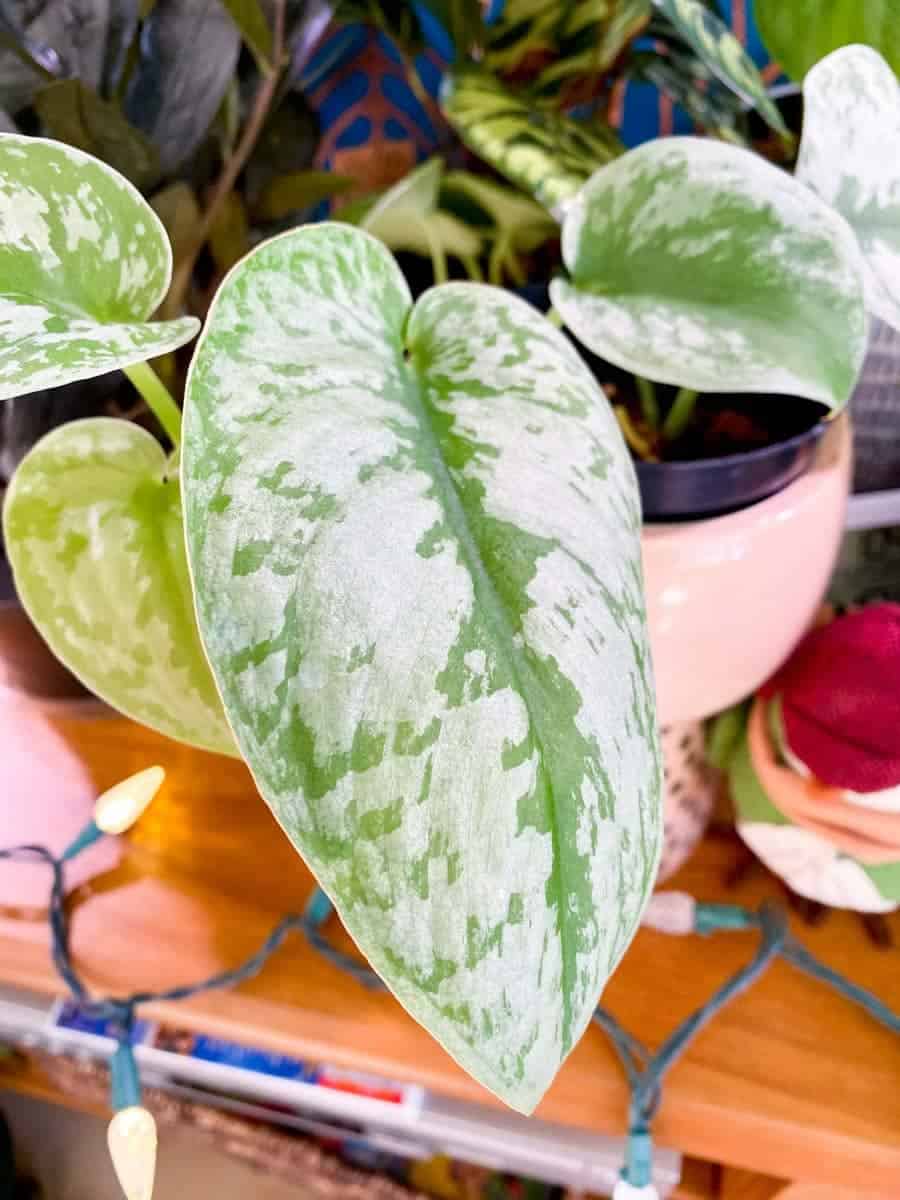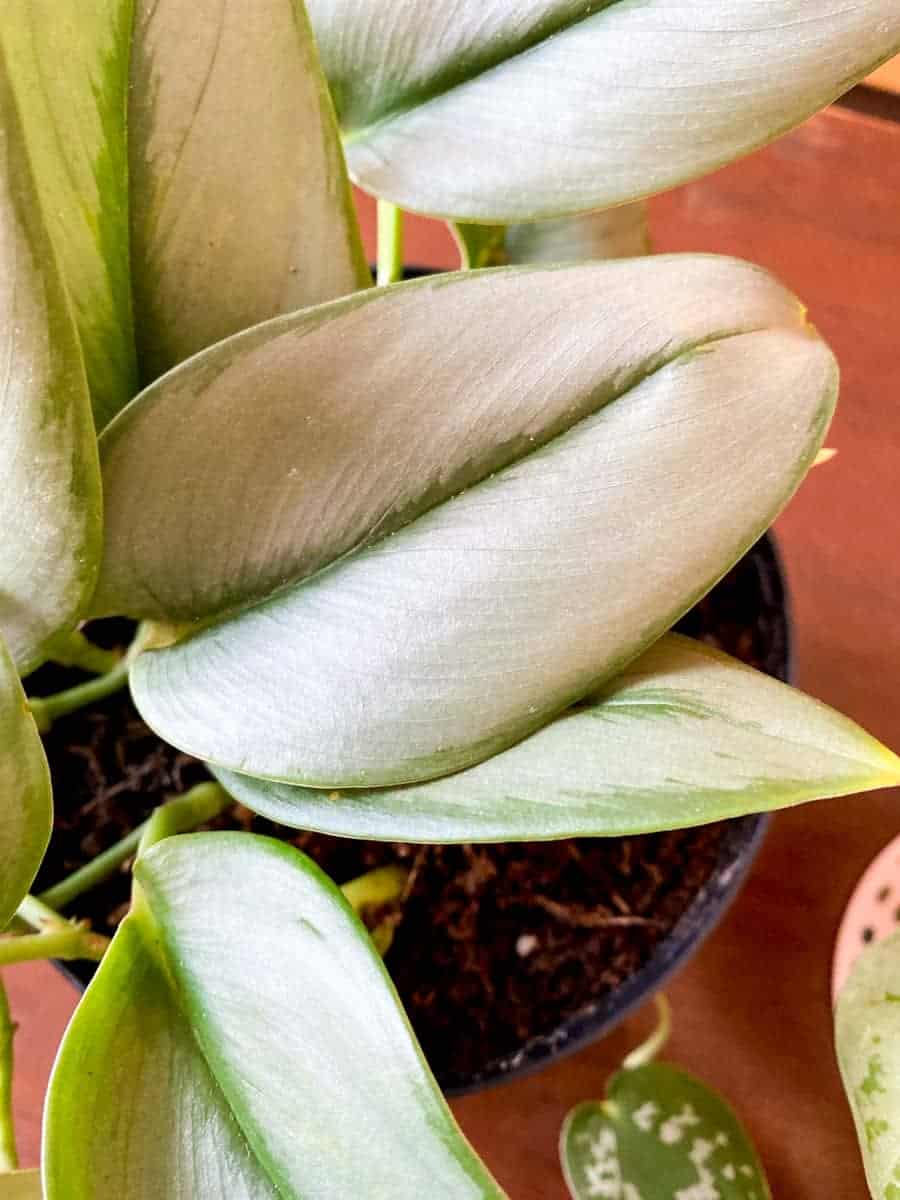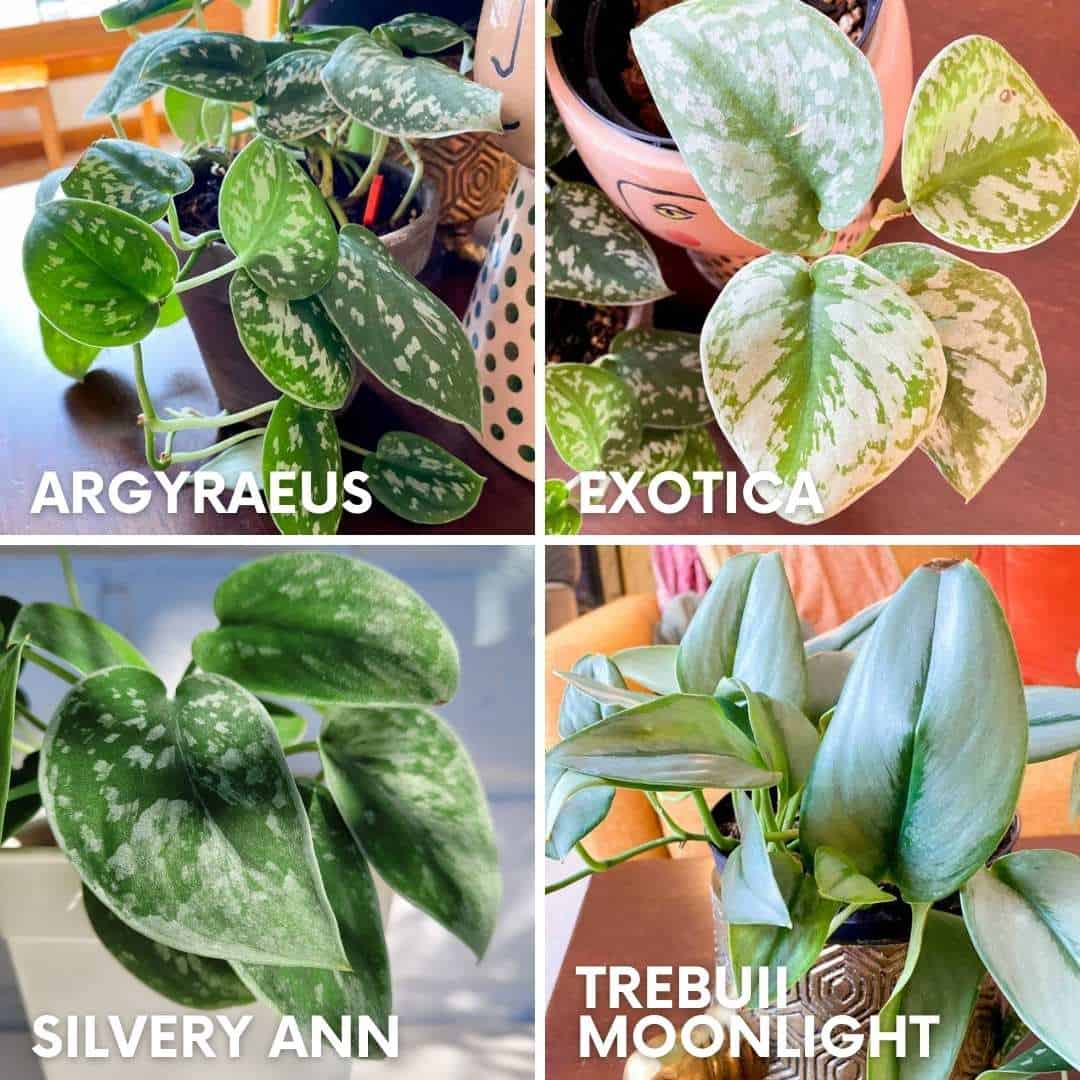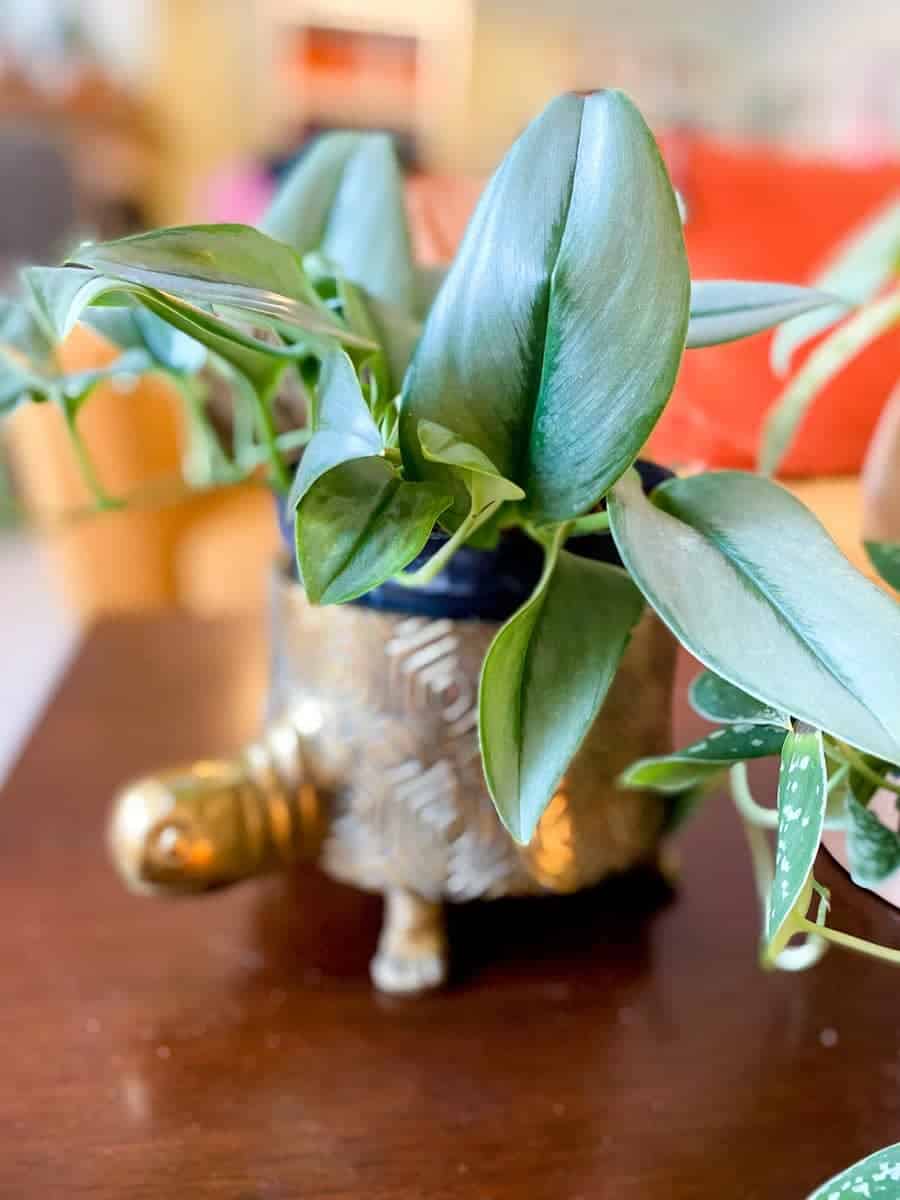I’m a sucker for a plant with a bit of sparkle and shine to it. In the depths of a freezing midwest winter, some greenery with a shimmer can add so much life and color to a home. If you also want to add some sparkle to your houseplant collection while still keeping everything low maintenance, consider the Scindapsus pictus.
These beautiful climbing or trailing plants are often referred to by the common names “silver satin pothos” or just “satin pothos.” And while pothos and Scindapsus plants have very similar appearances, growth habits, and care needs, they aren’t the same at all. The plants most commonly called pothos are Epipremnum aureum, while satin pothos are Scindapsus pictus.
Scindapsus pictus are native to Southeast Asia, where they use their aerial roots to climb trees. Most varieties have either silver variegation or shimmery silver leaves. Let’s talk about satin pothos care.

Table of Contents
Satin Pothos Care
Light requirements
Scindapsus pictus plants can handle a broad range of lighting conditions, just like pothos plants. They can grow in relatively low light up to bright light, as long as that bright light is filtered through a curtain, bounced off a wall, or otherwise adjusted to be indirect. Scindapsus pictus plants cannot handle bright direct sunlight.
If you notice your satin pothos is losing its silvery sheen or the spacing between new leaves on the stems is getting wider, your plant may need more light. Try moving it to a brighter location—this can also help stimulate growth on these typically slow growers.
Growfully Protip
If your plant is in a low-light location, it will likely need less frequent waterings. Be careful not to overwater—the soil should be mostly dry, and the pot should feel light before watering.
 Water requirements
Water requirements
Thanks to its thick leaves with an almost waxy finish, Scindapsus are good at retaining water and don’t need to be watered as often as some other tropical plants. Allow the soil to mostly dry out between waterings, but don’t let the soil dry completely.
To water, use a wooden chopstick or stake to gently poke holes in the soil for aeration. Pour water evenly over the soil’s surface until the water runs out of the drainage holes. Dump out any excess water that collects in the saucer or cachepot.
Soil and container requirements
Plant satin pothos plants in containers with drainage holes—the plants do not like to have wet feet, and a pot that doesn’t have drainage could lead to root rot in your Scindapsus.
Scindapsus also need well-draining soil—again, nobody wants root rot! Many people use a standard high-quality, store-bought potting mix. If you really want to make sure that your soil has good drainage (looking at you, folks who tend to overly love on their plants), consider mixing in some perlite, pumice, orchid bark, or coco chips.
 Humidity requirements
Humidity requirements
Scindapsus are fairly sturdy plants, and they are not as picky about their humidity as, say, calatheas. However, they are native to tropical environments, so they won’t do well in super dry air. Low humidity is likely the culprit if you notice crispy brown leaf tips developing on your plant. Try placing your container on a pebble tray, clustering your Scindapsus with other plants, or using a humidifier to boost the humidity around your plant.
Fertilizing
Only fertilize satin pothos when they show active growth, usually in the spring and summer. During the growing season, fertilize with a standard houseplant fertilizer about once a month or use a very diluted liquid fertilizer in your water at nearly every watering session.

How do I make the leaves of my satin pothos bigger?
The long vines of Scindapsus pictus make it a beautiful trailing plant, but if you want bigger leaves, you’ll need to turn your plant into a climber! In nature, satin pothos use their aerial roots to climb tree trunks and grow upwards. This allows them to grow larger leaves.
To replicate that at home, use a trellis, coco coir pole, or moss pole to train the Scindapsus to climb. Gently tie or pin the vines to the support until the aerial roots have taken hold. New growth will be bigger when a Scindapsus has room and support to climb.
Growfully Protip
If the leaves are particularly small and seem stunted, your plant may need more light.

How do you make satin pothos fuller?
One of the simplest ways to make a basket or container of Scindapsus pictus look more lush and full is to propagate the plant right there in its pot or hanging basket. Wrap the longest vines up over the soil, press the nodes into the soil, and gently pin them down. You can do this with bent bobby pins, pieces of floral wire, or propagation pins.
This encourages roots to develop at the pinned-down nodes, giving your plant new growth points.
Do satin pothos like direct sun?
While Scindapsus pictus plants can handle a wide variety of lighting conditions—from low light to brighter indirect light, the one light condition they can’t survive in (other than complete dark) is direct sunlight. Direct light is too intense for these plants and can scorch or bleach the leaves.

Why are the leaves curling on my silver satin pothos?
One of the reasons that Scindapsus and pothos plants are great for beginner plant parents is that they tell you when they need water. Scindapsus leaves will begin to curl on the edges when the plant needs water—it’s like the plant is telling you its needs!
Why are my silver pothos leaves turning yellow?
Most likely, the culprit behind yellowing leaves is overwatering or inconsistent watering. But if you’re pretty sure you’re watering on the right schedule and that your pot has proper drainage, there could be something else behind those yellow leaves.

How often should I water Scindapsus plants?
When the soil is dry, the pot feels light, and the edges of the leaves are starting to curl, it’s time to give your Scindapsus a big drink of water. You’ll need to water more often if your plant is in brighter light or if temperatures are warmer, but on average, expect to water your satin pothos every 1-2 weeks.
Varieties
There are several cultivars of satin pothos on the market. Here are some of our favorites:

- Argyraeus. The most common Scindapsus pictus variety. Has small splotches of silver variegation on smaller dark green leaves.
- Exotica. Has large leaves with big splashes of silver on lighter green foliage.
- Silvery Ann. Easily confused with Argyraeus, but many leaves have silvery edges, and some leaves are almost entirely silver.
- Trebuii Moonlight. The leaves of Trebuii moonlight are a pale, silvery green. Rather than having silver variegation, the whole leaves shine out to the edges.
Disease Problems
Scindapsus pictus is particularly prone to root rot. Make sure the plant is in well-draining soil in a container with drainage holes, and don’t allow water to stand in the cachepot or saucer.
Repotting your Scindapsus
Silver satin pothos are slow growers, so they won’t need to be repotted too often. If the soil is no longer retaining water, the roots are poking out from the drainage holes, or the plant is getting too top-heavy, it may be time to repot.

Propagating Satin Pothos
There are several ways to propagate Scindapsus pictus:
In the Container
As mentioned above, this method is great if you are looking to make a more lush container of satin pothos. Place the longest vines at the top of the pot, press their nodes into the soil, and use wire or propagation pins to pin the nodes down.
Water Propagation
When most people get started with propagation, they try water propagating. And with Scindapsus, it’s easy! Cut the stem of the plant between two growth nodes, leaving around one to two inches of stem below the cut node. Dip the cut end in rooting hormone (optional), and set in a clear glass container filled with water in a sunny spot. Change the water whenever it starts to get cloudy, or at least once a week, until the roots are 1-2″ long. Pot up the plant into potting soil.

Sphagnum Moss Propagation
Out of these three propagation methods, rooting cuttings in sphagnum moss is my favorite. To do this, you’ll need:
- Sphagnum moss that has been wetted and then wrung out. It should feel like a slightly damp sponge.
- A container with a tight-fitting, clear lid. I reuse plastic takeout containers with clear plastic lids, but some people make propagation boxes out of plastic storage totes. Make sure that the lid is clear so that light can reach the cuttings.
- Sharp, sanitized snips.
- Rooting powder or gel (optional).
- Line the bottom of the container with a layer of damp sphagnum moss.
- Cut the vine of the satin pothos between two growth nodes, leaving around 1-2″ of stem below the cut node.
- Dip the cut end of the cutting into the rooting powder or gel, if using.
- Place the cutting in the container so that the node is nestled into the moss and completely covered.
- Put the lid on, and set the container in a sunny spot that gets indirect light.
- Check on the cuttings about once a week, lightly dampening the moss if it starts to dry out.
That’s it! After about 3-6 weeks, the cuttings should be developing a root system. When the roots are 1-2″ long, pot the cuttings into a potting mix.
Growfully Protip
To help your fledgling plant adjust to life outside the propagation box, start leaving the lid off for a few hours a day for 3-5 days before potting into soil. This can help the cuttings adjust to the lower humidity they will soon be living in, without drying out the moss and roots.

Is Scindapsus pictus toxic to people or pets?
Unfortunately, yes. Keep this plant out of reach of cats, dogs, or small children who like to put things in their mouths.

Satin Pothos Care Tips (Scindapsus Care)
Materials
- Scindapsus Plant
- Well-draining soil
Tools
- Container with a Drainage Hole
Instructions

- Water wisely. Scindapsus are prone to root rot. Make sure the soil drains well, don't allow water to stand in the cachepot or saucer, and wait to water until the soil is mostly dry.
- Listen to your plant. Your satin pothos will tell you what it needs—if the leaves are beginning to curl on the edges, it needs water! Yellowing leaves are generally a sign of overwatering or inconsistent watering.
- Avoid direct sunlight. Satin pothos can handle low light or indirect bright light, but avoid putting your plant in direct sunlight. Direct light will scorch the leaves.
- Add some humidity. Crispy leaf tips are a sign that a scindapsus needs more humidity. Try putting it on a pebble tray, using a humidifier, or clustering it with other plants.
- Give it time. Scindapsus are generally slow growers, so you'll need some patience as you wait for new growth.


 Water requirements
Water requirements Humidity requirements
Humidity requirements




